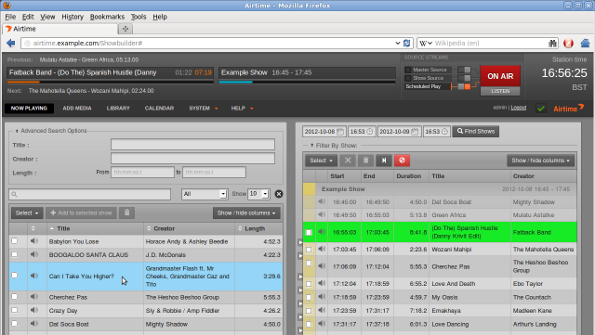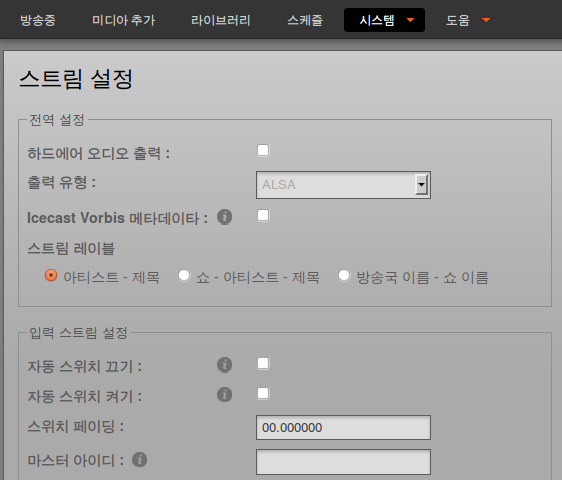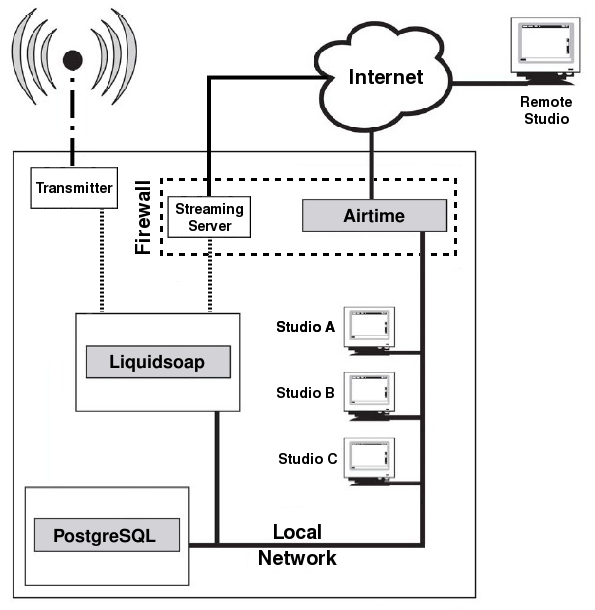Airtime 2.3 for Broadcasters
What is Airtime?
Updated for Airtime 2.3.1
Airtime is the open broadcast software for scheduling and remote station management. Web browser access to the station's media library, multi-file upload and automatic metadata import features are coupled with a collaborative on-line scheduling calendar and playlist management. The scheduling calendar is managed through an easy-to-use interface and triggers playout with sub-second precision.

Airtime has been intended to provide a solution for a wide range of broadcast projects, from community to public and commercial stations. The scalability of Airtime allows implementation in a number of scenarios, ranging from an unmanned broadcast unit accessed remotely through the Internet, to a local network of machines accessing a central Airtime storage system. Airtime supports the playout of lossy compressed audio files in both MP3 and AAC formats and the open, royalty-free equivalent Ogg Vorbis. It also supports playout of lossless FLAC and WAV format audio files.
Airtime manages the Liquidsoap stream generator at the heart of the system. Liquidsoap generates streams from files in the Airtime library and any remote input streams that you specify. The library is indexed in a PostgreSQL database to enable searching it. Live shows are automatically recorded with Ecasound, using the sound card line input. News editors, DJs and station controllers can use Airtime to build playlists or smart blocks and manage media files (upload, edit metadata, manage advertisements) inside the station or via the Internet.
The Airtime administration interface is designed to work with any web browser, on any desktop or mobile platform with a minimum display size of 1280x768 pixels. Airtime looks its best on a high definition display of 1920x1080 pixels. The recommended web browser is Mozilla Firefox 18 (or a later version). Google Chrome 24 (or later) and Apple Safari 6 (or later) are also supported.
Airtime can be localized into any language or dialect using the standard GNU gettext utility. Languages that are installed by default include Brazilian Portuguese, Chinese, Czech, English, French, German, Italian, Korean, Russian and Spanish. See the chapter Interface localization for details.

The scheduler in Airtime has a calendar view, organized by months, weeks and days. Here the program editors can schedule playlists and shows for their broadcast station. In some scenarios, the transmitter is situated outside the reach of the broadcaster and all program management has to be maintained through the web interface. Possible reasons for this scenario might be of a pragmatic nature (running many stations from one central office due to limited human resources) or an emergency (running a transmitter in a crisis area without putting staff at risk).
A fully managed Airtime Pro service is available from Sourcefabric. Airtime source code and packages for Debian and Ubuntu are also available for download, under the GNU General Public License version 3. If you're an Airtime Pro user, you can go straight to the Getting started chapter of this book and log in. If you wish to install Airtime on your own server, you should start at the Preparing the server chapter, and work your way through the installation steps. Alternatively, a demonstration server is available for public use at:
http://airtime-demo.sourcefabric.org/
Airtime workflow
This typical workflow is intended to clarify the difference between the various components that make up a complete Airtime system.
1. There are media files on a server, which include metadata in their tags (title, creator, genre and so on).
2. A PostgreSQL database contains the location of those media files and their metadata. This means you can search for and select a set of media files according to the specific metadata that you require, or use a 'smart block' to select the files for you. The database also contains details of remote input streams.
3. There is a Liquidsoap stream generator on the server which can take individual media files, playlists, smart blocks and remote input streams, and assemble them into a continuous output stream. This stream can be sent to a sound card (e.g. for a broadcast mixer, on the way to an FM or DAB transmitter) or to a streaming server for IP network distribution, such as LAN, local WiFi or the Internet. You can stream to a sound card and to IP networks with the same server, if you wish.
4. Icecast (http://www.icecast.org/) is the default streaming server, and there is also support for SHOUTcast (http://www.shoutcast.com), but in theory you could stream from Liquidsoap to any online service. If a suitable software interface is not available for your streaming service of choice, you can send audio from Liquidsoap to a separate encoding or streaming machine via a sound card.
5. Airtime manages all of these components, and provides an easy, multi-user web interface to the system. It enables your station staff to:
a) upload media files to the storage server via the Add Media page
b) automatically import file metadata into the PostgreSQL database
c) search for and download media files, and edit the metadata of individual files, if required, on the Library page
d) create and edit playlists of media files or create smart blocks of content based on metadata, and audition them. (Playlists and smart blocks are also saved in the database)
e) schedule broadcast shows (which can contain playlists, smart blocks, pre-recorded complete shows, remote input streams, or be live) for specific dates and times on the Calendar page
f) automatically record live shows at specific times and dates (in 256 kbps Ogg Vorbis format) from the sound card input with Ecasound, upload them to the storage server and import them into the database
g) manage presenter and other staff access to the broadcast schedule calendar, and their contact details, via the Manage Users page
h) see what is about to be played by Liquidsoap on the Now Playing page, with support for last-minute changes to the content
i) upload media files from Airtime to a third-party hosting service, such as SoundCloud
j) audition available output streams from the server using the Listen button
k) check the status and resource usage of system components on the Status page.
Example system
Combining Airtime, the Liquidsoap stream generator, the PostgreSQL database and file storage, you can supply a broadcast station with all the functionality needed for automation.
In the diagram below, the media files are stored on a server which also includes a PostgreSQL database, accessible through the local network. Liquidsoap outputs streams to both the transmitter and a streaming media server. The machine running Airtime is behind a firewall because it is connected both to the local network, and to the Internet for remote access. This enables Airtime to offer password-protected access to the media library and scheduling from both inside and outside the studio building.
